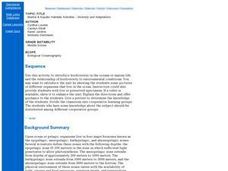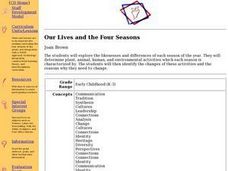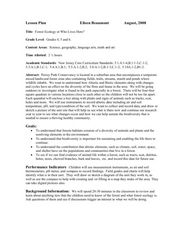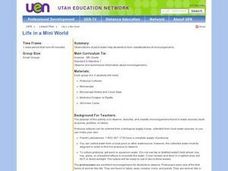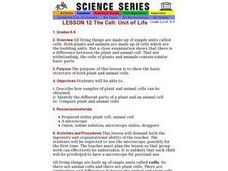Curated OER
Life Beyond Earth
Students investigate the solar system and what makes a planet habitable. They complete an online Webquest, simulate a NASA training program online, take an online quiz, answer discussion questions, and locate newspaper articles about the...
Curated OER
Seas Of Life
Young scholars brainstorm examples of predator and prey that are featured in a video they watch. For this investigative lesson students will research an animal from the video and explain if it is a predator or prey and how it helps...
Curated OER
Life In the Flood Zone
Students discover how floods occur by visiting the Weather Channel's website. They examine the areas of the United States which are more vulnerable for flooding. They research the history of previous floods and how to protect themselves.
Curated OER
You Are What You Eat: Plastics and Marine Life
Young scholars study the different types of plastics and see which ones sink or remain buoyant. In this ocean environmental lesson plan students complete several handouts, and view a film on PBS.
Curated OER
Marine & Aquatic Habitats Activities - Diversity and Adaptations
Students analyze biozones and how to identify and diagram them. They also research which organisms can adapt to different biozones.
Curated OER
The Life Of Bees
Students explore the matriarchal structure of a bee colony. They participate in various activities to identify the structure of a bee colony and the roles of each type of bee plays in the colony. Vocabulary and a worksheet with answer...
Curated OER
Blue Genes: Affect Your Life!
Learners, in groups, research, analyze and synthesize information on genetic diseases. After watching a video on genetics, groups perform research on a variety of genetic diseases and present their findings to the class.
Curated OER
Our Lives and the Four Seasons
Students compare and contrast the four seasons. Using this information, they determine the plant, animal and environmental activities that can be enjoyed in each season. They discuss why the seasons must change and how humans adapt to them.
Curated OER
Physical Science: Solar Energy
Learners review and discuss how Solar energy and electricity produce light and heat. They create a photo/picture journal and include pictures taken during solar energy activities to a PowerPoint slide presentation.
Curated OER
Understanding Life System: Growth and Changes in Plants
Third graders research ways in which plants are essential to humans. In this Global Peace lesson, 3rd graders participate in tasks, such as creating a propaganda poster. Students may watch the film, The Lorax, as a closing activity.
Curated OER
Forest Ecology or Who Lives Here?
Students explore a hardwood forest. In this forest ecology lesson, students examine the diversity and animals and plants as they explore their habitats at Poricy Park Conservatory. Students determine how biodiversity and abiotic elements...
Curated OER
Science: What Is the Carbon Cycle?
Students examine the carbon cycle while identifying its sources, sinks, and release agents. Using magazines and newspapers, groups of students design collages illustrating the carbon cycle. Finally, they write responses to several...
Curated OER
Science In Society
Fifth graders study diseases that are related to the use of alcohol, tobacco, and drugs, both prescription and illegal. They determine illnesses that can occur as a direct result of the use of or inappropriate use of these substances....
Curated OER
Agriculture in Your Life
Students explore the origins of food and other everyday products around the United States. In this agricultural lesson, students learn basic vocabulary and practice matching common items with their agricultural source. They categorize...
Curated OER
Circle of Life
Students consider why we eat and where our food obtains its energy. They illustrate food chains that might be found on an open field, dissect owl pellets, identify the remains of animals in the pellets, watch videos and participate in...
Curated OER
Testing for Life
Students discuss food and the food groups and their organic nature. They test 3 different solutions and test for protein, starch and glucose. In addition, they create a master table on the board to collect all the teams results.
Curated OER
Life in a Mini World
Sixth graders observe, describe, and classify microorganisms found in water sources. In small groups, they make their own slide, observe the Protozoa under a microscope, and record and classify the microorganisms.
Curated OER
Sociology: What is life like for Gulf Coast rice farmers
Students read 1 page about Gulf Coast rice farmers and then describe what rice farming in the U.S. is like in the United States. In this rice farming lesson plan, students tell why they would or would not want to be a rice farmer.
Curated OER
Diversity of Life
Students compare the different classifications and explore how organisms are grouped. In this classification lesson students study images of organisms and answer questions.
Curated OER
The Cell: Unit of Life
Pupils identify the parts of plant and animal cells, how samples can be obtained and what the differences are.
Curated OER
Dirt Life
Students select and collect soil samples from a variety of locations (schoolyard, home, etc.). They do this lab after an interest-generating discussion about "dirt" and microbes. Students make a dilution in sterile water, plate it on a...
Curated OER
Diversity of Life
Students study Arthropods and their characteristics. In this organisms lesson students explore the success of Arthropods and answer questions.
Curated OER
The Tree of Life
Learners discover the amount of diversity that exists in a local area using simple techniques that make observing biodiversity easy and enjoyable. They select a tree to study, collect vials of specimens, then identify the arthropod.
Curated OER
Diversity of Life
Pupils identify the difference between eukaryote and prokaryotes and examine the structure of bacteria. In this bacteria lesson students examine the different ways that bacteria are classified through an activity.




